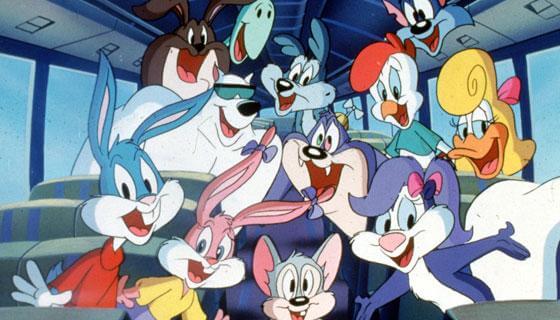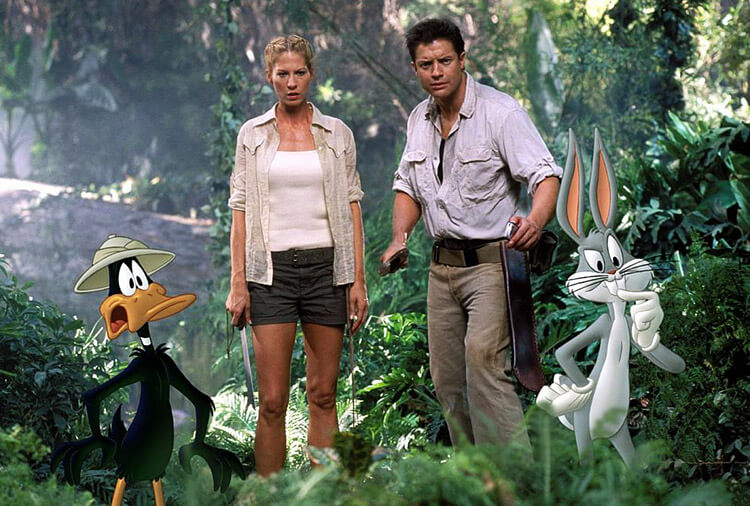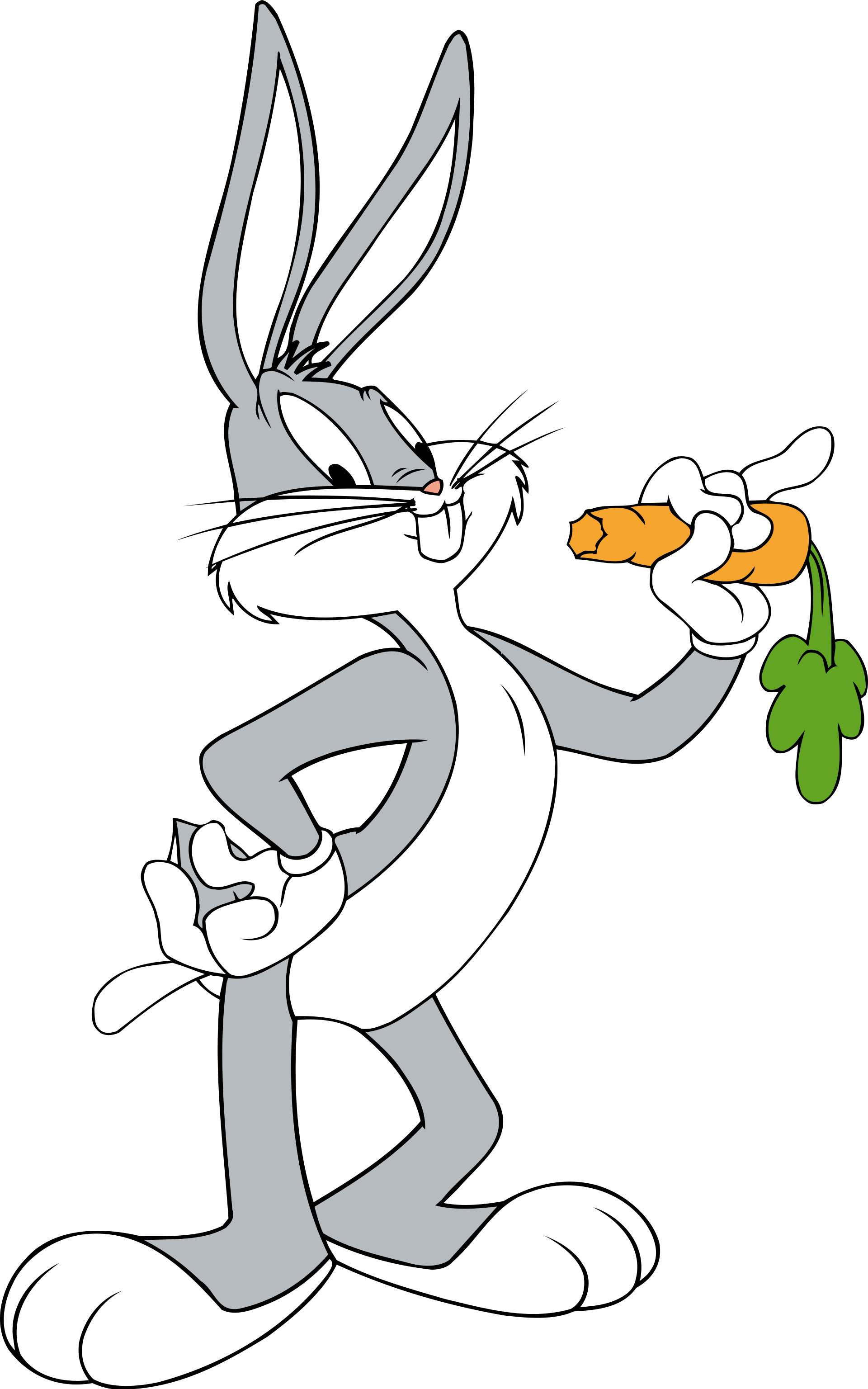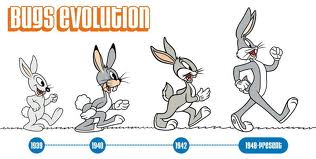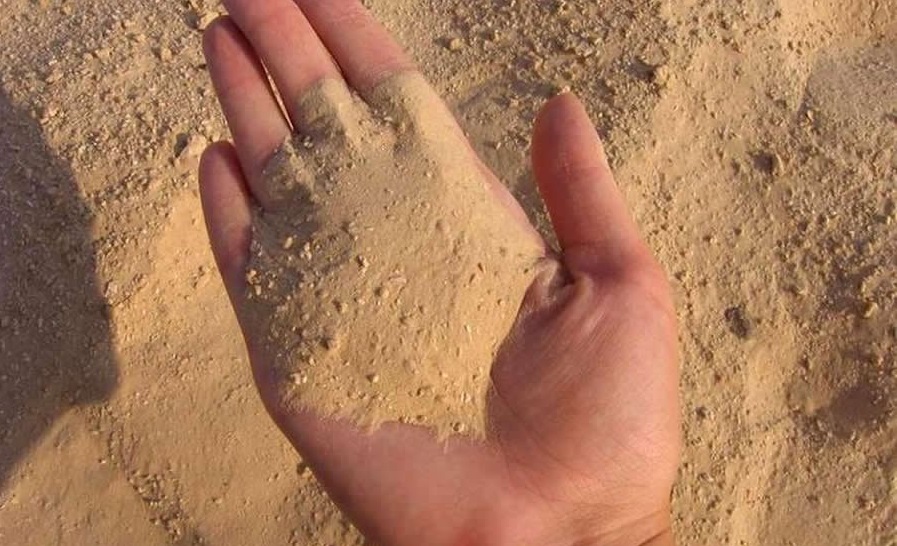- В чем дело, Багз Банни?
- Первое появление хитрого кролика
- Как кролика назовешь…
- Голос Багза Банни
- Официальный дебют
- Фильмография
- Биография кролика
- Друзья Bugs Bunny
- Bugs Bunny
- Contents
- History
- Bugs’ Precursor
- Bugs’ Official Debut
- World War II
- The Postwar Era
- After the Classic Cartoon Era
- More Recent Years
- Personality & Catchphrases
- Rabbit or Hare?
- Openings & Closings of Shorts
- Voice Actors
В чем дело, Багз Банни?
Смелый, находчивый и веселый кролик Bugs Bunny – любимец детишек всего мира и страшный сон заядлых охотников. Жизнерадостный зверек легко справляется со сложностями и обводит вокруг пальца врагов, не выпускает из лап полезной морковки, мило улыбается и вежливо интересуется делами некоего «Дока». А между тем Багзу Банни скоро стукнет уже 75 лет. По такому случаю кролик согласился рассказать немного о себе.
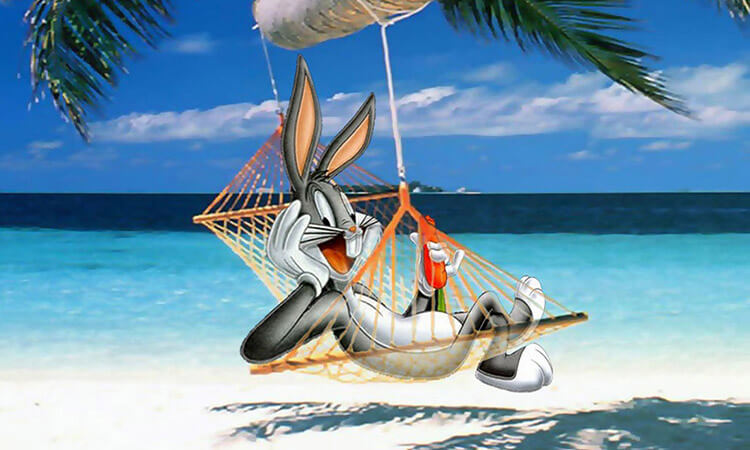
Багза Банни с уверенностью можно назвать одним из самых известных на планете кроликов. Он давно уже перерос границы родного мира анимационных сериалов Looney Tunes и Merrie Melodies, успел покрасоваться на большом экране в настоящем кино, стал символом компании Warner Brothers, принес создателям несколько Оскаров и заполучил личную звезду на Аллее Славы в Голливуде. Таким знаменитым Багза сделали природное обаяние, яркая внешность, некоторое нахальство, занимательные сюжеты приключений и, конечно, произносимая с бруклинским акцентом и морковным хрустом легендарная фраза «What’s up, Doc?» («В чем дело, Док?»).
Первое появление хитрого кролика
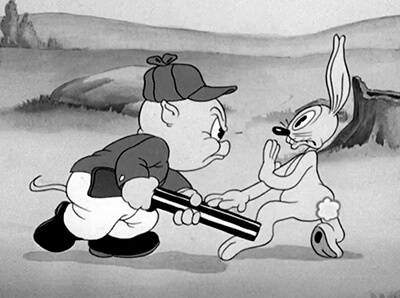
Безымянный кролик настолько полюбился зрителям, что его создатели решили не останавливаться на достигнутом. В 1939 году прототип появился в мультике «Prest-O Change-O» Чака Джонса. В том же году вышел «Hare-um Scare-um» режиссеров Кола Далтона и Бена Хардавэя, где мех зверька стал серым. Далее художники работали над формой головы и ростом Багза. К 1940 году кролик приобрел более современный вид и впервые встретил охотника Элмера Фадда в мультфильме «Elmer’s Candid Camera». До окончательного превращения в Багза Банни оставались детали – работа над голосом и именем.
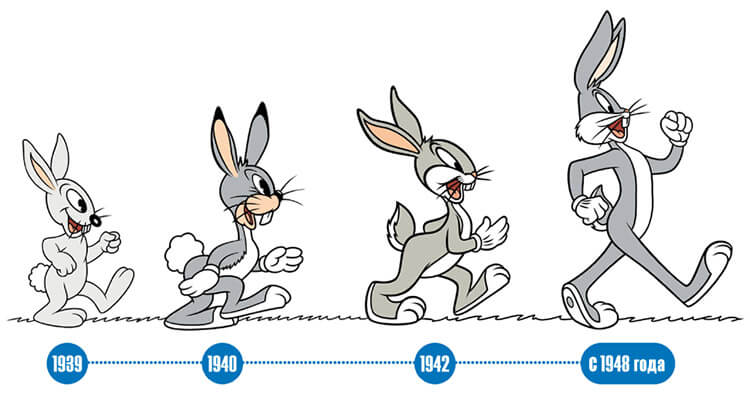
Как кролика назовешь…
С английского языка «Bunny» переводится «Кролик, или Зайчонок», а «Bugs» — «ненормальный, рехнувшийся». Можно подумать, что такое имя персонаж получил вполне обдуманно и заслуженно. Ну, разве нормальные кролики ведут себя подобным образом? Однако на самом деле имя Bugs Bunny (Багз Банни) родилось абсолютно случайно и унаследовано героем от режиссера Бена Хардавэя.
В рамках компании Warner Brothers у отца кролика было свое прозвище, точнее – ник во внутренней сети. Как вы догадались, звали его Бен «Bugs» Хардавэй. Однажды режиссер поручил художнику Чарли Торсону (Charlie Thorson) доработать образ персонажа. Тот с успехом выполнил поручение и подписал рисунок «Bugs’ Bunny», т.е. «Кролик Багза» или «Кролик для Багза». Со временем из прозвища кролика исчез апостроф, а имя Бакс Бани окончательно прижилось и стало собственным.
Голос Багза Банни
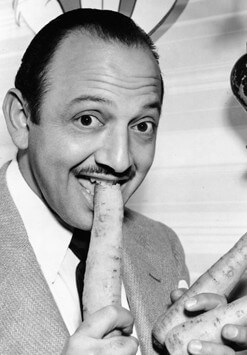
Нельзя сказать, что роль голоса Багза Банни давалась Бланку очень легко. За время работы актеру пришлось пережевать не один килограмм морковки. В мультфильме кролик постоянно жует этот полезный овощ и часто говорит с набитым ртом. Практика показала, что ни один другой продукт не издает настолько звучного хруста, как морковь. Вот и приходилось Бланку постоянно откусывать, жевать и выплевывать любимую еду кролика. На этой почве даже поползли слухи о жуткой аллергии актера на морковь. Другие источники уверяли, что Бланк просто не переносит вкуса овоща. Позднее в интервью актер опроверг все эти версии. Выплевывал он морковь лишь ради экономии времени на площадке.
За такой серьезный подход к делу и талантливую озвучку Мела Бланка однажды отблагодарил сам Bugs Bunny. Кролик буквально вытащил свое второе «я» с того света. В один отнюдь не прекрасный день Мел Бланк попал в серьезную автомобильную аварию, получив перелом черепа и впав на 3 недели в кому. Вывести актера из тяжелого состояния долго пытались самыми разными способами. Ничего не помогало. Пока доктор не решил спросить Бланка: «В чем дело, Багз Банни?». Актер моментально ответил на фразу голосом любимого кролика и пришел в себя.
Официальный дебют
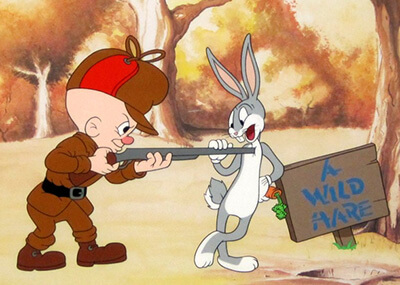
Следующий знаковый мультфильм – «Elmer’s Pet Rabbit» («Домашний кролик Элмера») 1941 года режиссера Чака Джонса. В нем впервые фигурировало имя Bugs Bunny в начальных титрах картины. Хотя внешность и голос персонажа были выполнены еще в старой манере. После «Elmer’s Pet Rabbit» облик Багза вернулся к утвержденному ранее классическому варианту, а в титрах постоянно стали указывать уже официальное имя героя.
Фильмография
За свою творческую карьеру Bugs Bunny снялся в огромном количестве короткометражных мультфильмов и даже в 2 полнометражных картинах. С 1941 года кролик начал появляться в анимационном сериале Warner Brothers «Looney Tunes». С 1942 года он стал звездой еще одного сериала «Merrie Melodies». Оба шоу выходили в так называемый «Золотой век американской анимации». В период с 1940 по 1964 годы Bugs Bunny появился в 167 эпизодах анимационных сериалов.
Во второй половине века у Багза началась новая жизнь.
- С 1960 по 2000 годы Bugs блистал на телевидении в антологиях Looney Tunes.
- В 1990 году и вовсе переродился в нового персонажа — кролика-тинейджера Бастера Банни. Бастер стал отдельным героем мультсериала «Tiny Toon Adventures» («Приключения мультяшек»), продолжателем идей Багза. Сериал о кролике-подростке и его друзьях оказался весьма успешным, просуществовал с 1990 по 1995 годы.
- В 2002 году появился мультсериал «Baby Looney Tunes» («Малыши Луни Тюнз»), где известные всем персонажи окончательно помолодели, превратившись в трехлетних детишек. Здесь нашего героя звали Baby Bugs (Малыш Багз). За 3 года существования вышло 53 серии мультика.
- С 2011 года на канале Cartoon Network транслируется анимационный сериал «The Looney Tunes Show» («Шоу Луни Тюнз») со старым добрым взрослым Багзом Банни. Вместе с Даффи Даком и другими героями прежних мультиков кролик перебрался в большой город, где сталкивается с новыми проблемами и ввязывается в разные приключения.
Помимо перечисленных сериалов Bugs Bunny появляется в десятках эпизодов других короткометражных мультфильмов, как камео или второстепенный герой.
Кроме того, кролик стал звездой полнометражных фильмов «Космический джем» (1996) и «Луни Тюнз: Снова в деле» (2003). В обеих картинах игровое кино с живыми актерами совмещено с анимацией. В первом фильме партнерами Багза Банни стали Майкл Джордан и Билл Мюррей, а во втором – Брендан Фрейзер, Стив Мартин и Тимоти Далтон.
Биография кролика
Помимо реальной биографии у Багза Банни есть и вымышленная. Историю своей жизни он сам рассказывает в мультфильме «What’s up, Doc?». Bugs Bunny родился в Бруклине (Нью-Йорк) в семье обычных безымянных кроликов. Уже в раннем детстве у Багза открылся музыкальный талант, и он начал успешно играть на игрушечном фортепиано. Далее была танцевальная школа, любительские спектакли. После окончания школы кролик решил стать актером. Он долгое время пел в хоре, а затем после неудачного дебюта в главной роли ушел из театра.
Важнейшим событием в карьере Багза Банни стала встреча с Элмером Фаддом, который к тому времени уже был звездой водевилей и искал партнера для очередного номера. Среди нескольких претендентов Элмер выбрал грустного кролика. Вместе актеры показывали комедийные сценки, в которых объектом насмешек обычно становился Багз. Но на одном из представлений в Нью-Йорке кролик позволил себе импровизацию и провернул все трюки уже над Элмером. Напарник жутко разозлился и направил на Багза ружье. Кролик от страха и неожиданности выдал: «В чем дело, Док?». Публика была в восторге и аплодировала стоя. Далее Багз и Элмер начали сниматься в разных фильмах и стали настоящими звездами Голливуда.
Друзья Bugs Bunny
В классических мультфильмах («Looney Tunes» и «Merrie Melodies») у Багза Банни не так много друзей. Чаще всего кролик пересекается с охотником Элмером Фаддом и поросенком Порки, соперничает с Даффи Даком, наблюдает за гонками Хитрого Койота и Дорожного бегуна. Из мультсериалов нового времени и полнометражных фильмов мы узнаем, что Багз Банни мило общается и с другими персонажами «Looney Tunes». Например, с котом Сильвестром, канарейкой Твити и тасманским дьяволом Тазом.
Уже после завершения золотого века американской анимации у Bugs Bunny появилась подружка – Lola Bunny (Лола Банни). Придумали очаровательную крольчиху специально для фильма «Космический джем», где она демонстрирует потрясающий баскетбольный талант. Далее Лола стала постоянной участницей новых сериалов о Багзе Банни и его второй половинкой.
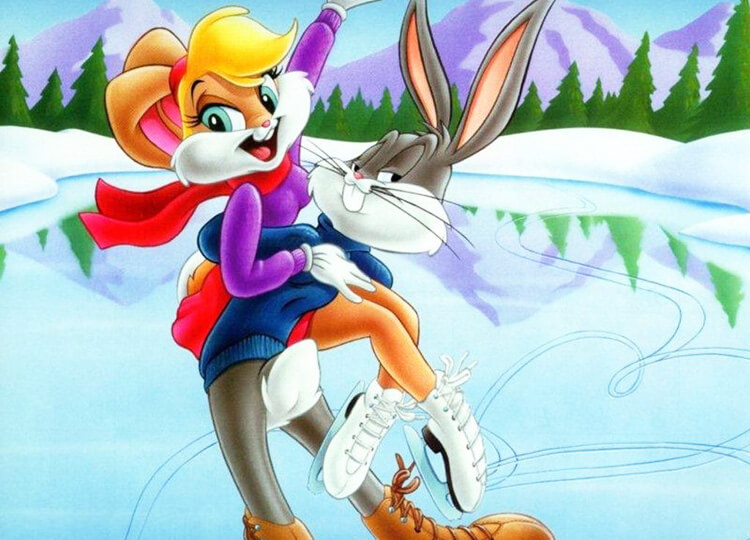
Bugs Bunny и его друзья – любимые мультипликационные герои детишек по всему миру. Приключения находчивого остроумного кролика увлекают, вызывают интерес и повышают настроение. Массу приятных эмоций гарантирует и популярная продукция с героями, например, детское постельное белье с Багз Банни.
Источник статьи: http://info.spim.ru/info/child_world/V-chem-delo-Bagz-Banni_1081_51_article.html
Bugs Bunny
This article is about the adult version of Bugs Bunny. For the baby version of the character seen in Baby Looney Tunes, see Baby Bugs.
Bugs Bunny is an animated cartoon character. He is best known for his starring roles in the Looney Tunes and Merrie Melodies series of theatrical short films produced by Warner Bros. during the Golden Age of American Animation. His popularity during this era led to his becoming an American cultural icon, as well as a corporate mascot of the Warner Bros. company. [2] He was originally voiced by Mel Blanc, but is now voiced by a variety of voice actors. [3] Bugs is an anthropomorphic gray hare, famous for his relaxed, passive personality, pronounced Mid-Atlantic accent (Blanc described the voice as being a mixture of Brooklyn and Bronx accents [4] ), depiction as a mischievous trickster, and his catchphrase «Eh, what’s up, doc?» usually said while chewing a carrot. Since his official debut in 1940’s «A Wild Hare», [5] Bugs has appeared in various short films, feature films, compilations, TV series, music records, comic books, video games, award shows, amusement park rides, and commercials. He has also appeared in more films (short and feature length) than any other cartoon character, [6] is the ninth most-portrayed film personality in the world, [6] and has his own star on the Hollywood Walk of Fame. [7] When TV Guide compiled a list of the fifty greatest cartoon characters of all time as part of the magazine’s 50th anniversary in 2002, Bugs Bunny was given the honor of Number One. [8] [9] In a CNN broadcast, a TV Guide editor talked about the group that created the list. The editor also explained why Bugs pulled top billing: «His stock. has never gone down. Bugs is the best example. of the smart-aleck American comic. He not only is a great cartoon character, he’s a great comedian. He was written well. He was drawn beautifully. He has thrilled and made many generations laugh. He is tops.» [10] ContentsHistoryBugs’ PrecursorBugs’ evolution from Happy Rabbit to the present According to Chase Craig, who was a member of Tex Avery’s cartoon unit and later wrote and drew the first Bugs Bunny comic Sunday pages and Bugs’ first comic book; «Bugs was not the creation of any one man but rather represented the creative talents of perhaps five or six directors and many cartoon writers. In those days, the stories were often the work of a group who suggested various gags, bounced them around and finalized them in a joint story conference.» [11] Happy Rabbit, a hare with some of the personality of Bugs (though looking very different), made his first appearance in the cartoon short Porky’s Hare Hunt, released on April 30, 1938. Co-directed by Ben Hardaway and an uncredited Cal Dalton (who was responsible for the initial design of the rabbit), this short has an almost identical plot to Tex Avery’s Porky’s Duck Hunt, which had introduced Daffy Duck. Hare Hunt replaced the little black duck with a small white rabbit. Porky Pig was again cast as a hunter tracking a silly prey who is more interested in driving his pursuer insane and less interested in escaping. Happy introduced himself with the odd expression «Jiggers, fellers,» and Mel Blanc gave the character a voice and laugh much like those he would later use for Woody Woodpecker. Hare Hunt also gave Happy the famous Groucho Marx line, «Of course you realize, this means war!» The rabbit character was popular enough with audiences that the Termite Terrace staff decided to use it again. [12] [13] According to Friz Freleng, Hardaway and Dalton had decided to dress the duck in a rabbit suit. The white rabbit had an oval head and a shapeless body. In characterization, he was «a rural buffoon». He was loud, zany with a goofy, guttural laugh. Blanc provided him with a hayseed voice. [14] Happy returned in the short Prest-O Change-O, directed by Chuck Jones, where he is the pet rabbit of unseen character Sham-Fu The Magician. Two dogs, fleeing the local dogcatcher, enter his absent master’s house. Happy harasses them but is ultimately bested by the bigger of the 2 dogs. Happy’s third appearance came in Hare-um Scare-um, once again directed by Hardaway and Dalton. This short (the first in which he is depicted as a gray bunny instead of a white one) is also notable as Happy’s first singing role. Charlie Thorson, lead animator on the short, gave the character a different name. He had written «Bugs’ Bunny» on the model sheet that he drew for Hardaway. In promotional material for the short, including a surviving 1939 press kit, the name on the model sheet was altered to become the rabbit’s own name: «Bugs» Bunny (quotation marks only used, on and off, until 1944). [15] In Chuck Jones’ Elmer’s Candid Camera, Happy met Elmer Fudd for the first time. In this cartoon, Happy looked more like the present-day Bugs, taller and with a similar face—-but retaining the more primitive voice. Elmer’s character design was also different: fatter and taller than the modern model, although Arthur Q. Bryan’s character voice was already established. Animation historians identify these Happy Rabbit cartoons as Bugs Bunny’s early cartoons before he reaches his fame in A Wild Hare, as evident in documentaries such as The Wabbit Turns 50 from WWOR in 1990. [16] Bugs’ Official DebutBugs emerges (literally) for the first time in A Wild Hare. A Wild Hare, directed by Tex Avery and released on July 27, 1940, is widely considered to be the first official Bugs Bunny cartoon. [17] It is the first film where both Elmer Fudd and Bugs, both redesigned by Bob Givens, are shown in their fully developed forms as hunter and tormentor, respectively; the first in which Mel Blanc uses what would become Bugs’ standard voice; and the first in which Bugs uses his catchphrase, «What’s up, Doc?» [18] A Wild Hare was a huge success in theaters and received an Academy Award nomination for Best Cartoon Short Subject. [19] Immediately following on A Wild Hare, Bob Clampett’s Patient Porky featured a cameo appearance by Bugs, announcing to the audience that 750 rabbits have been born. The gag uses Bugs’ Wild Hare visual design, but his goofier pre-Wild Hare voice characterization. The second full-fledged role for the mature Bugs, Chuck Jones’ Elmer’s Pet Rabbit, was the first to use the name Bugs Bunny on-screen: it appears in a title card, «featuring Bugs Bunny,» at the start of the short (which was edited in following the success of A Wild Hare). However, Bugs’ voice in this cartoon is significantly different, and his design was slightly altered as well. After Pet Rabbit, however, subsequent Bugs appearances returned to normal: the Wild Hare visual design and personality returned, and Blanc reused the Wild Hare voice characterization. The name «Bugs» or «Bugsy» as an old-fashioned nickname means «crazy» (or «loopy»). Several famous people from the first half of the twentieth century had that nickname, like famous gangster, Benjamin «Bugsy» Siegel, who disliked the nickname. It is now out of fashion as a nickname, but survives in 1950’s–1960’s expressions like «you’re bugging me», as in «you’re driving me crazy». Hiawatha’s Rabbit Hunt, directed by Friz Freleng, became the second Bugs Bunny cartoon to receive an Academy Award nomination. [20] The fact that it didn’t win the award was later spoofed somewhat in What’s Cookin’ Doc?, in which Bugs demands a recount after losing the Oscar to James Cagney and presents a clip from Hiawatha’s Rabbit Hunt to prove his point. [21] ‘ World War IIBy 1942, Bugs had become the number one star of Merrie Melodies. The series was originally intended only for one-shot characters in films after several early attempts to introduce characters (Foxy, Goopy Geer, and Piggy) failed under Harman–Ising. By the mid-1930s, under Leon Schlesinger, Merrie Melodies started introducing newer characters. Bugs Bunny Gets the Boid shows a slight redesign of Bugs, with less-prominent front teeth and a rounder head. The character was reworked by Robert McKimson, then an animator in Bob Clampett’s unit. The redesign at first was only used in the films created by Clampett’s unit, but in time it would be taken up by the other directors, with Friz Freleng and Frank Tashlin the first. When McKimson was himself promoted to director, he created yet another version, with more slanted eyes, longer teeth and a much larger mouth. He used this version until 1949 (as did Art Davis for the one Bugs Bunny film he directed) when he started using the version he had designed for Clampett. Chuck Jones would come up with his own slight modification, and the voice had slight variations between the units. Bugs also made cameos in Tex Avery’s final Warner Bros. cartoon, Crazy Cruise. [22] Since Bugs’ debut in A Wild Hare, he appeared only in color Merrie Melodies films (making him one of the few recurring characters created for that series in the Schlesinger era prior to the full conversion to color), alongside Elmer predecessor Egghead, Inki, Sniffles, and Elmer himself. While Bugs made a cameo in Porky Pig’s Feat, this was his only appearance in a black-and-white Looney Tunes film. He did not star in a Looney Tunes film until that series made its complete conversion to only color cartoons beginning in 1944. Buckaroo Bugs was Bugs’ first film in the Looney Tunes series and was also the last Warner Bros. cartoon to credit Schlesinger (as he had retired and sold his studio to Warner Bros. that year). [23] Bugs’ popularity soared during World War II because of his free and easy attitude, and he began receiving special star billing in his cartoons by 1943. By that time, Warner Bros. had become the most profitable cartoon studio in the United States. [24] In company with cartoon studios such as Disney and Famous Studios, Warners pitted its characters against Adolf Hitler, Benito Mussolini, Francisco Franco, and the Japanese. Bugs Bunny Nips the Nips features Bugs at odds with a group of Japanese soldiers. This cartoon has since been pulled from distribution due to its depiction of Japanese people. [25] He also faces off against Hermann Göring and Hitler in Herr Meets Hare, which introduced his well-known reference to Albuquerque as he mistakenly winds up in the Black Forest of ‘Joimany’ instead of Las Vegas. [26] Bugs also appeared in the 1942 two-minute U.S. war bonds commercial film Any Bonds Today?, along with Porky and Elmer.
At the end of Super-Rabbit, Bugs appears wearing a United States Marine Corps dress blue uniform. As a result, the Marine Corps made Bugs an honorary Marine Master Sergeant. [27] From 1943 to 1946, Bugs was the official mascot of Kingman Army Airfield, Kingman, Arizona, where thousands of aerial gunners were trained during World War II. Some notable trainees included Clark Gable and Charles Bronson. Bugs also served as the mascot for 530 Squadron of the 380th Bombardment Group, 5th Air Force, U.S. Air Force, which was attached to the Royal Australian Air Force and operated out of Australia’s Northern Territory from 1943 to 1945, flying B-24 Liberator bombers. [28] Bugs riding an air delivered torpedo served as the squadron logo for Marine Torpedo/Bomber Squadron 242 in the Second World War. Additionally, Bugs appeared on the nose of B-24J #42-110157, in both the 855th Bomb Squadron of the 491st Bombardment Group (Heavy) and later in the 786th BS of the 466th BG(H), both being part of the 8th Air Force operating out of England. In 1944, Bugs Bunny made a cameo appearance in Jasper Goes Hunting, a Puppetoons film produced by rival studio Paramount Pictures. In this cameo, Bugs (after being threatened at gunpoint) pops out of a rabbit hole, saying his usual catchphrase; after hearing the orchestra play the wrong theme song, he realizes «Hey, I’m in the wrong picture!» and then goes back in the hole. [29] Bugs also made a cameo in the Private Snafu short Gas, in which he is found stowed away in the titular private’s belongings; his only spoken line is his usual catchphrase. The Postwar EraAfter World War II, Bugs continued to appear in numerous Warner Bros. cartoons, making his last «Golden Age» appearance in 1964’s False Hare. He starred in over 167 theatrical short films, most of which were directed by Friz Freleng, Robert McKimson and Chuck Jones. Freleng’s Knighty Knight Bugs, in which a medieval Bugs trades blows with Yosemite Sam and his fire-breathing dragon (which has a cold), won an Oscar (becoming the first Bugs Bunny cartoon to win said award). [30] Three of Jones’ films — Rabbit Fire, Rabbit Seasoning, and Duck! Rabbit, Duck! — compose what is often referred to as the «Rabbit Season/Duck Season» trilogy and are famous for originating the «historic» rivalry between Bugs and Daffy Duck. [31] Jones’ classic What’s Opera, Doc?, casts Bugs and Elmer Fudd in a parody of Richard Wagner’s Der Ring des Nibelungen. It was deemed «culturally significant» by the United States Library of Congress and selected for preservation in the National Film Registry in 1992, becoming the first cartoon short to receive this honor. [32]
Bugs and Daffy in the intro to The Bugs Bunny Show In the fall of 1960, ABC debuted the prime-time television program The Bugs Bunny Show. This show packaged many of the post-1948 Looney Tunes shorts with newly animated wraparounds. After two seasons, it was moved from its evening slot to reruns on Saturday mornings. The Bugs Bunny Show changed format and exact title frequently but remained on network television for 40 years. The packaging was later completely different, with each short simply presented on its own, title and all, though some clips from the new bridging material were sometimes used as filler. [33] After the Classic Cartoon EraBugs did not appear in any of the post-1964 Looney Tunes and Merrie Melodies shorts produced by DePatie-Freleng Enterprises or Seven Arts Productions, nor did he appear in the lone Looney Tunes TV special produced by Filmation Associates. He would not appear in new material on-screen again until Bugs and Daffy’s Carnival of the Animals aired in 1976. [34] From the late 1970s through the 1980s, Bugs was featured in various animated specials for network TV, such as Bugs Bunny’s Howl-oween Special, Bugs Bunny’s Looney Christmas Tales and Bugs Bunny’s Bustin’ Out All Over. Bugs also starred in the independently-produced documentary Bugs Bunny: Superstar during this time, as well as Warner Bros.’ various compilation films. [35] [36] He also appeared in The Bugs Bunny Road-Runner Movie, Looney Looney Looney Bugs Bunny Movie, Bugs Bunny’s 3rd Movie: 1001 Rabbit Tales and Daffy Duck’s Quackbusters.
In the 1988 live-action/animated movie Who Framed Roger Rabbit (from executive producer Steven Spielberg), Bugs appeared as one of the inhabitants of Toontown. However, since the film was being produced by Disney, Warner Bros. would only allow the use of their biggest star if he got an equal amount of screen time as Disney’s biggest star, Mickey Mouse. Because of this, both characters are always together in frame when onscreen. Roger Rabbit also featured one of Mel Blanc’s final performances as the voice of Bugs (as well as the other Looney Tunes characters) before his death in 1989. Bugs later appeared in another animated production featuring numerous characters from rival studios: the 1990 drug prevention TV special Cartoon All-Stars to the Rescue. [37] [38] [39] This special is notable for being the first time that someone other than Blanc voiced Bugs and Daffy (both characters were voiced by Jeff Bergman for this). Bugs also made guest appearances in the early 1990s television series Tiny Toon Adventures, as the principal of Acme Looniversity and the mentor of Buster Bunny. He made further cameos in Warner Bros.’ subsequent animated TV shows Taz-Mania, Animaniacs, and Histeria! Bugs returned to the silver screen in 1990’s Box Office Bunny. This was the first Bugs Bunny cartoon since 1964 to be released in theaters and it was created for Bugs’ 50th-anniversary celebration. It was followed by Blooper Bunny, a cartoon that was shelved from theaters, [40] but later premiered on Cartoon Network in 1997 and has since gained a cult following among animation fans for its edgy humor. [41] [42] [43] In 1996, Bugs and the other Looney Tunes characters appeared in the live-action/animated film, Space Jam, directed by Joe Pytka and starring NBA superstar Michael Jordan. The film also introduced the character Lola Bunny, who becomes Bugs’ new love interest. Space Jam received mixed reviews from critics, [44] [45] but was a box office success (grossing over $230 million worldwide). [46] The success of Space Jam led to the development of another live-action/animated film, Looney Tunes: Back in Action, released in 2003 and directed by Joe Dante. Unlike Space Jam, Back in Action was a box-office bomb, [47] though it did receive more positive reviews from critics. [48] [49] [50] In 1997, Bugs appeared on a U.S. postage stamp, the first cartoon to be so honored, beating the iconic Mickey Mouse. The stamp is number seven on the list of the ten most popular U.S. stamps, as calculated by the number of stamps purchased but not used. The introduction of Bugs onto a stamp was controversial at the time, as it was seen as a step toward the ‘commercialization’ of stamp art. The postal service rejected many designs and went with a postal-themed drawing. Avery Dennison printed the Bugs Bunny stamp sheet, which featured «a special ten-stamp design and was the first self-adhesive souvenir sheet issued by the U.S. Postal Service.» [51] More Recent YearsA younger version of Bugs was the main character of Baby Looney Tunes, which debuted on Kids’ WB in 2001. In the action-comedy Loonatics Unleashed, his definite descendant Ace Bunny was the leader of the Loonatics team and seemed to have inherited his ancestor’s Brooklyn accent and comic wit. [52]
In 2011, Bugs Bunny and the rest of the Looney Tunes gang returned to television in the Cartoon Network sitcom, The Looney Tunes Show, with Jeff Bergman returning to voice both Bugs and Daffy Duck regularly for the first time since 1992’s Invasion of the Bunny Snatchers. The characters feature new designs by artist Jessica Borutski. Among the changes to Bugs’ appearance were the simplification and enlargement of his feet, as well as a change to his fur from gray to a shade of mauve (though in the second season, his fur was changed back to gray). [53] In the series, Bugs and Daffy are portrayed as best friends as opposed to their usual pairing as rivals or frenemies. At the same time, Bugs is more openly annoyed at Daffy’s antics in the series (sometimes to the point of aggression), compared to his usual carefree personality from the original cartoons. Bugs and Daffy are close friends with Porky Pig in the series, although Bugs tends to be a more reliable friend to Porky than Daffy is. Bugs also dates Lola Bunny in the show, although at first, he finds her to be «crazy» and a bit too talkative (he later learns to accept her personality quirks, similar to his tolerance for Daffy). Unlike the original cartoons, Bugs lives in an upper-middle-class house, which he shares with Daffy, Taz (whom he treats as a pet dog) and Speedy Gonzales, in the middle of a cul-de-sac with their neighbors Yosemite Sam, Granny and Witch Lezah. According to the episode «Peel of Fortune», Bugs’ financial success comes from his invention of the carrot peeler. In 2015, Bugs starred in the direct-to-video film Looney Tunes: Rabbits Run, [54] and later returned to television yet again as the star of Cartoon Network and Boomerang’s new comedy series New Looney Tunes, where he returned to his original trickster personality from the original shorts. [55] [56] In 2020, he began appearing in Looney Tunes Cartoons on HBO Max. In this series, Bugs gives his full name as Bugsworth Bunny, and is reverted to his original early-1940s character design and characterization, complete with yellow gloves. Personality & CatchphrasesBugs outsmarts Daffy and Elmer in Rabbit Seasoning. He is a cunning, charismatic, and smart rabbit. These personality traits are what gives him an advantage over his enemies, rivals, and opponents. He is also known for his famous catchphrase; «Eh, what’s up, doc?», which he typically uses as a greeting to anyone he encounters (usually while munching a carrot). Bugs is characterized as being clever and capable of outsmarting anyone who antagonizes him, including Elmer Fudd, Yosemite Sam, Willoughby, Marvin the Martian, Beaky Buzzard, Daffy Duck, Porky Pig, the Tasmanian Devil, Cecil Turtle, Witch Hazel, Rocky and Mugsy, Wile E. Coyote, The Crusher, The Gremlin, Count Bloodcount, and a whole bunch of others. Bugs almost always wins these contentions, a story pattern which recurs in Looney Tunes cartoons directed by Chuck Jones. Concerned that viewers would lose sympathy for an aggressive protagonist who always won, Jones arranged for Bugs to be bullied, cheated, or threatened by the antagonists while minding his own business, justifying his subsequent antics as retaliation or self-defense. He’s also been known to break The 4th Wall by «communicating» with the audience, either by explaining the situation (e.g. «Be with you in a minute, folks!»), describing someone to the audience (e.g. «Feisty, ain’t they?»), clueing in on the story (e.g. «That happens to him all during the picture, folks.»), explaining that one of his antagonists’ actions have pushed him to the breaking point («Of course you know, this means war.»), admitting his own deviousness toward his antagonists («Gee, ain’t I a stinker?»), etc. When Bugs made his appearance, he promptly replaced Daffy Duck as the most popular Warner Bros. character. Daffy, jealous of his cartoon counterpart’s ascension to fame, has on many occasions attempted to dethrone the rabbit. But he has never truly succeeded, always being outsmarted by the clever hare. However, as time passed on, Bugs and Daffy’s rivalry has turned friendlier in nature as the two usually hang out together in most cartoons and Bugs considers Daffy his best friend despite his faults, to which Daffy says the same thing. Bugs will usually try to placate the antagonist and avoid contention, but when a villain pushes him too far, Bugs may address the audience and invoke his catchphrase «Of course you realize this means war!» before he retaliates, and the retaliation will be devastating. This line was taken from Groucho Marx and others in the 1933 film Duck Soup and was also used in the 1935 Marx film A Night at the Opera. [57] Bugs would pay homage to Groucho in other ways, such as occasionally adopting his stooped walk or leering eyebrow-raising (in Hair-Raising Hare, for example) or sometimes with a direct impersonation (as in Slick Hare).
Bugs about to give Yosemite Sam the shaft (in more ways than one) in Bugs Bunny Rides Again Other directors, such as Friz Freleng, characterized Bugs as altruistic. When Bugs meets other successful characters (such as Cecil Turtle in Tortoise Beats Hare, or, in World War II, the Gremlin of Falling Hare), his overconfidence becomes a disadvantage. Most of Bugs’ adversaries are extremely dim-witted, and Bugs is easily able to outwit and torment them, although on occasion they will manage to get the best of Bugs. Daffy Duck, who is arguably more intelligent but less clever, is unaffected by Bugs’ usual schemes, which usually results in the two trying to outsmart the other with Bugs always triumphing in the end. However, there are only 4 antagonists that successfully defeats Bugs in the end of the cartoon, such as Cecil Turtle, the Gremlin from Falling Hare, the unnamed mouse from Rhapsody Rabbit, and the fly from Baton Bunny. During the 1940s, Bugs started off immature and wild (similar to Daffy), but by the 1950s his personality matured and his attitude became more refined and less frenetic. Although often shown as highly clever, Bugs is never actually malicious, and only acts as such in self-defense against his aggressors. The only exceptions where Bugs ever serves as an antagonist are the following: Elmer’s Pet Rabbit, Wabbit Twouble, The Wacky Wabbit, Buckaroo Bugs, and Duck Amuck; Elmer’s Pet Rabbit depicts him completely out-of-character with a more aggressive, selfish, arrogant, almost thuggish personality. Wabbit Twouble and The Wacky Wabbit depict him as a prankster harassing Elmer Fudd in the vein of early Daffy Duck/Porky Pig cartoons featuring the screwball Daffy as the tormentor. Buckaroo Bugs depicts him as a true villain, while Duck Amuck depicts him as far more sadistic than usual, as he becomes an animator and uses his newfound powers to torture Daffy. Bugs Bunny’s nonchalant carrot-chewing standing position, as explained by Chuck Jones, Friz Freleng, and Bob Clampett, originated in a scene in the 1934 film It Happened One Night, in which Clark Gable’s character leans against a fence, eating carrots rapidly and talking with his mouth full to Claudette Colbert’s character. This scene was well known while the film was popular, and viewers at the time likely recognized Bugs Bunny’s behavior as satire. The carrot-chewing scenes are generally followed by Bugs Bunny’s most well-known catchphrase, «What’s up, Doc?», which was written by director Tex Avery for his first Bugs Bunny short, 1940’s A Wild Hare. Avery explained later that it was a common expression in his native Texas and that he did not think much of the phrase. When the short was first screened in theaters, the «What’s up, Doc?» scene generated a tremendously positive audience reaction. As a result, the scene became a recurring element in subsequent films and cartoons. The phrase was sometimes modified for a situation. For example, Bugs says «What’s up, dogs?» to the antagonists in A Hare Grows in Manhattan, «What’s up, Duke?» to the knight in Knight-Mare Hare and «What’s up, prune-face?» to the aged Elmer in The Old Grey Hare. He might also greet Daffy with «What’s up, Duck?» He used one variation, «What’s all the hub-bub, bub?» only once, in Falling Hare. Another variation is used in Looney Tunes: Back in Action when he greets a bubble gun-yielding Marvin The Martian saying «What’s up, Darth?» (a reference to Darth Vader from the Star Wars film series).
Bugs faces off with Toro in «Bully for Bugs». Several Chuck Jones shorts in the late 1940s and 1950s depict Bugs traveling via cross-country (and, in some cases, intercontinental) tunnel-digging, ending up in places as varied as Mexico (Bully for Bugs), The Himalayas (The Abominable Snow Rabbit) and Antarctica (Frigid Hare) all because he «shoulda taken that left toin at Albukoikee.» He first utters that phrase in 1945’s Herr Meets Hare, when he emerges in the Black Forest, a cartoon seldom seen today due to its blatantly topical subject matter. When Hermann Göring says to Bugs, «Zair is no Las Vegas in Chermany» and takes a potshot at Bugs, Bugs dives into his hole and says, «Joimany? YIPE!», as Bugs realizes he’s behind enemy lines. The confused response to his «left toin» comment also followed a pattern. For example, when he tunnels into Scotland in My Bunny Lies over the Sea, while thinking he’s heading for the La Brea Tar Pits in Los Angeles, California, it provides another chance for an ethnic stereotype: «Therrre’s no La Brrrea Tarrr Pits in Scotland!» (to which Bugs responds, «Uh. what’s up, Mac-doc?»). A couple of late-1950s/early 1960s shorts of this ilk also featured Daffy Duck travelling with Bugs («Since when is Pismo Beach inside a cave?!»).
Bugs revealed as the unseen animator in Duck Amuck Bugs Bunny has some similarities to figures from mythology and folklore, such as Br’er Rabbit, Nanabozho, or Anansi, and might be seen as a modern trickster (for example, he repeatedly uses cross-dressing mischievously). Unlike most cartoon characters, however, Bugs Bunny is rarely defeated in his own games of trickery. One exception to this is the short Hare Brush, in which Elmer Fudd ultimately carries the day at the end; however, critics note that in this short, Elmer and Bugs assume each other’s personalities—through mental illness and hypnosis, respectively—and it is only by becoming Bugs that Elmer can win. However, Bugs was beaten at his own game. In the short Duck Amuck he torments Daffy Duck as the unseen animator, ending with his line, «Ain’t I a stinker?» Bugs feels the same wrath of an unseen animator in the short Rabbit Rampage where he is in turn tormented by Elmer Fudd. At the end of the clip Elmer gleefully exclaims, ‘Well, I finally got even with that scwewy wabbit!» Bugs wears white gloves, which he is rarely seen without, although he may remove one and use it for slapping an opponent to predicate a duel. Another glove-less example is Long-Haired Hare, where Bugs pretends to be the famed conductor Leopold Stokowski and instructs opera star «Giovanni Jones» to sing and to hold a high note. As Giovanni Jones is turning red with the strain, Bugs slips his left hand out of its glove, leaving the glove hovering in the air in order to command Jones to continue to hold the high note. Bugs then nips down to the mail drop to order, and then to receive, a pair of ear defenders. Bugs puts on the ear defenders and then zips back into the amphitheater and reinserts his hand into his glove as singer Jones is writhing on the stage, still holding that same high note.
Bugs uses disguise to fool Elmer in What’s Opera, Doc? Bugs Bunny is also a master of disguise: he can wear any disguise that he wants to confuse his enemies: in Bowery Bugs he uses diverse disguises: fakir, gentleman, woman, baker and finally policeman. This ability of disguise makes Bugs famous because we can recognize him while at the same time realizing that his enemies are stumped. Bugs has a certain preference for the female disguise: Taz, Elmer Fudd, Yosemite Sam were fooled by this sexy bunny (woman) and in Hare Trimmed, Sam discovers the real face of «Granny» (Bugs’s disguise) in the church where they attempt to get married. Bugs dressed as a female hunter, a temptress, the beautiful Brunhlide, a sexy lady and many others to fool Elmer Fudd and he also kissed him in his nose twice (Bugs and Elmer also happily got married in the end of «Rabbit of Seville»[Elmer as the bride and Bugs as the groom], as well as in «Bugs’ Bonnets»). For all the gullible victims off all these disguises, however, for some reason, Daffy Duck and Cecil Turtle were among those who are never fooled. Bugs Bunny may also have some mystical potential. In Knight-Mare Hare he was able to return to his bunny form (after being transformed into a donkey) by removing his donkey form as if it were a suit. Merlin of Monroe (the wizard) was unable to do the same thing. Later Bugs Bunny defeated the Count Blood Count in a magical spell duel. However, the story was a dream and Bugs Bunny’s victory over Count Blood Count was a result of his intellect, not innate magical power. Rabbit or Hare?The animators throughout Bugs’ history have treated the terms rabbit and hare as synonymous. Taxonomically, they are not synonymous, being somewhat similar but observably different types of lagomorphs. Hares have much longer ears than rabbits, so Bugs might seem to be of the hare family, yet rabbits live in burrows, as Bugs is seen to do. Many more of the cartoon titles include the word «hare» rather than «rabbit,» as «hare» lends itself easily to puns («hair,» «air,» etc.). Within the cartoons, although the term «hare» comes up sometimes, again typically as a pun—-for example, Bugs drinking «hare tonic» to «stop falling hare» or being doused with «hare restorer» to bring him back from invisibility—-Bugs as well as his antagonists most often refer to the character as a «rabbit.» The word «bunny» is of no help in answering this question, as it is a synonym for both young hares and young rabbits. Coney is yet another term for rabbit, explaining Bugs’ frequent fondness for Coney Island. In Nike commercials with Michael Jordan, Bugs is referred to as «Hare Jordan.» Openings & Closings of ShortsBugs (standing in for Porky) in the closing to Hare Tonic and Baseball Bugs In the opening of many of the Bugs Bunny cartoons, the Merrie Melodies and Looney Tunes irises contain Bugs Bunny’s head after the Warner Bros. shield (generally from 1944 to 1945 and 1949 onward). Others have Bugs Bunny relaxing on top of the Warner Bros. shield: He chews on his carrot, looks angrily at the camera and pulls down the next logo (Merrie Melodies or Looney Tunes) like a window shade (generally on cartoons between 1945 until early 1949). Then he lifts it back up, to now be seen lying on his own name, which then fades into the title of the specific short. In some other cases, the title card sometimes fades to him, already on his name and chewing his carrot then fade to the name of the short. At the finish of Hare Tonic and Baseball Bugs, Bugs breaks out of a drum (like Porky Pig) and says, «And dat’s de end». Also, at the end of Box Office Bunny, right after Daffy Duck and Elmer Fudd run out through the «That’s All Folks!» sequence, Bugs later comes in through the rings and says, «And that’s all, folks!». He did the ending for the last time at the end of Space Jam, but this time saying «Well, that’s all, folks!». Some old, damaged TV prints of pre-1948 shorts such as The Up-Standing Sitter had a print where Bugs Bunny came out of the drum, with the 1937-38 Merrie Melodies closing music, he didn’t say anything albeit his mouth still moves (due to the dubbing over of the audio) and the music did not even finish. Voice Actors
The BIGGEST LOONEY TUNES COMPILATION Bugs Bunny, Daffy Duck and more! Cartoons for Children — HD Источник статьи: http://looneytunes.fandom.com/wiki/Bugs_Bunny | ||||||||||||||||

